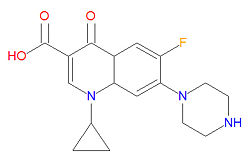Ciprofloxacin: Difference between revisions
imported>David E. Volk (New page: {{subpages}} right|thumb|250px|{{#ifexist:Template:Ciprofloxacin structure.jpg/credit|{{Ciprofloxacin structure.jpg/credit}}<br/>|}}Ciprofloxacin '''...) |
mNo edit summary |
||
| (7 intermediate revisions by 4 users not shown) | |||
| Line 1: | Line 1: | ||
{{subpages}} | {{subpages}} | ||
{{Image|Ciprofloxacin structure.jpg|right|250px|Ciprofloxacin}} | |||
'''Ciprofloxacin''' is a broad-spectrum antimicrobial carboxyfluoroquinoline used to treat [[urinary tract infections]], uncomplicated [[cystitis]], [[prostatitis]], lower [[respiratory tract infections]], [[sinusitis]], skin infections, bone and joint infections, infectious diarrhea, [[tyfoid fever]], cervical and urethral [[gonorrhea]], and post-exposure [[anthrax]]. Because it works by a different mechanism than other classes of [[antibiotic]]s, it can be used to treat some drug-resistant pathogens. | '''Ciprofloxacin''' is a broad-spectrum antimicrobial carboxyfluoroquinoline used to treat [[urinary tract infections]], uncomplicated [[cystitis]], [[prostatitis]], lower [[respiratory tract infections]], [[sinusitis]], skin infections, bone and joint infections, infectious diarrhea, [[tyfoid fever]], cervical and urethral [[gonorrhea]], and post-exposure [[anthrax]]. Because it works by a different mechanism than other classes of [[antibiotic]]s, it can be used to treat some drug-resistant pathogens. | ||
== Mechanism of | == Mechanism of action == | ||
The mechanism of action of [[quinolones]], including ciprofloxacin, is different from that of other antimicrobial agents such as [[beta-lactam]]s, [[macrolide]]s, [[tetracycline]]s, or [[aminoglycoside]]s; therefore, organisms resistant to these drugs may be susceptible to ciprofloxacin. There is no known cross-resistance between ciprofloxacin and other classes of antimicrobials. The bactericidal action of ciprofloxacin results from inhibition of the enzymes topoisomerase II (DNA gyrase) and topoisomerase IV, which are required for bacterial DNA replication, transcription, repair, and recombination. | The mechanism of action of [[quinolones]], including ciprofloxacin, is different from that of other antimicrobial agents such as [[beta-lactam]]s, [[macrolide]]s, [[tetracycline]]s, or [[aminoglycoside]]s; therefore, organisms resistant to these drugs may be susceptible to ciprofloxacin. There is no known cross-resistance between ciprofloxacin and other classes of antimicrobials. The bactericidal action of ciprofloxacin results from inhibition of the enzymes topoisomerase II (DNA gyrase) and topoisomerase IV, which are required for bacterial DNA replication, transcription, repair, and recombination. | ||
== Chemistry == | == Chemistry == | ||
Ciprofloxacin's IUPAC chemical name is 1-cyclopropyl-6-fluoro-4-oxo-7-piperazin-1-ylquinoline-3-carboxylic acid and it has chemical formula C<sub>17</sub>H<sub>18</sub>FN<sub>3</sub>O<sub>3</sub> (MW = 331.3415 g/mol). | Ciprofloxacin's IUPAC chemical name is 1-cyclopropyl-6-fluoro-4-oxo-7-piperazin-1-ylquinoline-3-carboxylic acid and it has chemical formula C<sub>17</sub>H<sub>18</sub>FN<sub>3</sub>O<sub>3</sub> (MW = 331.3415 g/mol). | ||
== | == Primary Sources == | ||
{{CZMed}}[[Category:Suggestion Bot Tag]] | |||
Latest revision as of 17:02, 28 July 2024
Ciprofloxacin is a broad-spectrum antimicrobial carboxyfluoroquinoline used to treat urinary tract infections, uncomplicated cystitis, prostatitis, lower respiratory tract infections, sinusitis, skin infections, bone and joint infections, infectious diarrhea, tyfoid fever, cervical and urethral gonorrhea, and post-exposure anthrax. Because it works by a different mechanism than other classes of antibiotics, it can be used to treat some drug-resistant pathogens.
Mechanism of action
The mechanism of action of quinolones, including ciprofloxacin, is different from that of other antimicrobial agents such as beta-lactams, macrolides, tetracyclines, or aminoglycosides; therefore, organisms resistant to these drugs may be susceptible to ciprofloxacin. There is no known cross-resistance between ciprofloxacin and other classes of antimicrobials. The bactericidal action of ciprofloxacin results from inhibition of the enzymes topoisomerase II (DNA gyrase) and topoisomerase IV, which are required for bacterial DNA replication, transcription, repair, and recombination.
Chemistry
Ciprofloxacin's IUPAC chemical name is 1-cyclopropyl-6-fluoro-4-oxo-7-piperazin-1-ylquinoline-3-carboxylic acid and it has chemical formula C17H18FN3O3 (MW = 331.3415 g/mol).
Primary Sources
The most up-to-date information about Ciprofloxacin and other drugs can be found at the following sites.
- Ciprofloxacin - FDA approved drug information (drug label) from DailyMed (U.S. National Library of Medicine).
- Ciprofloxacin - Drug information for consumers from MedlinePlus (U.S. National Library of Medicine).
- Ciprofloxacin - Detailed information from DrugBank.
